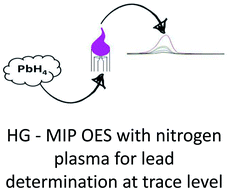Lead determination by HG-MIP OES with nitrogen plasma after a variable optimization study
Abstract
A hydride generation nitrogen microwave induced plasma optical emission spectrometry (HG-MIP OES) system was developed for lead determination. Plumbane chemical generation was performed using 0.045 mol L−1 K3Fe(CN)6 as the additive in acidic medium and 2.0% w/v NaBH4 in 1% w/v NaOH as the reductant. The additivated sample and the reductant were pumped towards a cyclonic chamber where hydride generation and separation from the solution occurred. Operating conditions such as the additive and reductant concentration, sample, reductant and nitrogen flow-rate, the cyclonic chamber stabilization time and the viewing position in the torch were optimized. A meticulous study of the variation of the nitrogen plasma response as a function of the hydrochloric acid concentration was carried out. The analytical performance of the method was studied and its applicability evaluated in a Trace Element in Water Certified Reference Material and a Soil Reference Material. The method performance in terms of limits of detection and quantification (0.54 μg L−1 and 1.8 μg L−1 Pb, respectively) was found comparable to other atomic spectrometry techniques. This is to our knowledge the first research on the analytical performance of lead determination by PbH4 generation and determination by MIP OES.



 Please wait while we load your content...
Please wait while we load your content...